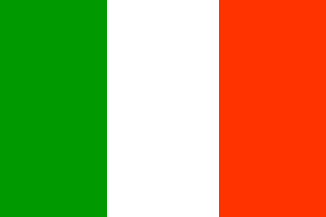 |
 |
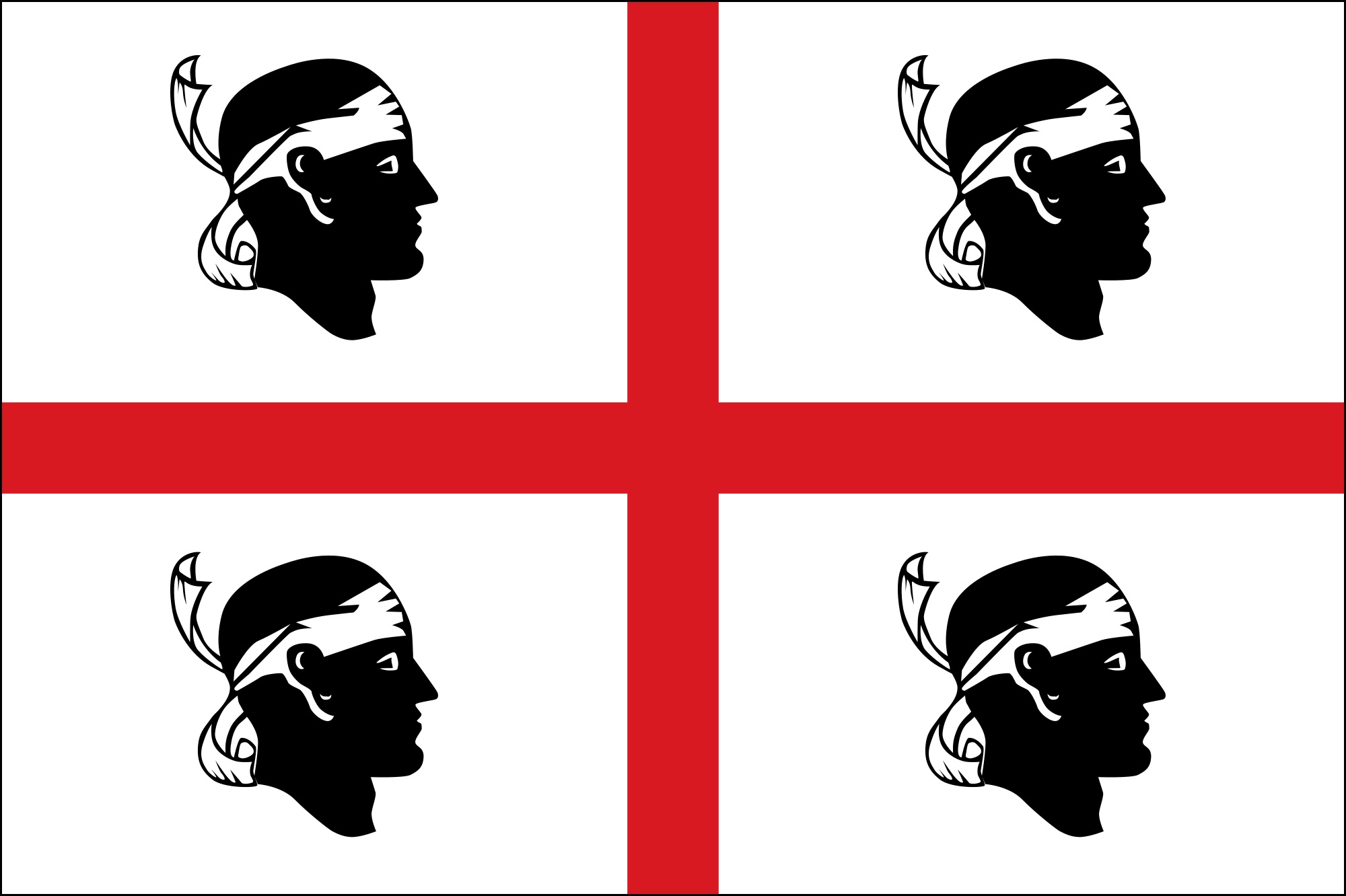 Part 2 Part 2 |
Wednesday
Santa Teresa de Gallura - Alghero: 156 km, 2.5 hrs
After breakfast and coffee in the upper town of Bonifacio we enjoy a bit of sun and the views from our balcony . At 10.30 am we head towards port. I leave Erik at the ferry terminal with the baggage andWeather: cloudy, 19⁰C
Thursday 12 May 2016
Alghero - Bosa: 40km, 1 hr (one way)
Erik starts the day with buying In the afternoon we call Navisarda to ask whether a boat trip to the Neptune cave is on this afternoonn. That is not the case. The sea is still rough.
Then we go, as an alternative, to Bosa, a town on the river Temo. This is the only navigable river in Sardinia. It is a monumental town about 40 km south of Alghero. The road winds along the coast and it takes almost an hour to get there. The current city was founded in the 12th century. The Malaspina Castle ruin overlooks the city. We start with a drink in Piazza Constizione. We walk along the well-preserved palaces at Via Vittorio Emanuele towards the cathedral. We take a look inside. The interior is richly decorated. Notable are the four lions on the edges of the steps to the altar. Then we walk to the old bridge spanning the Temo and then back again to the car via the quay along the river . We drive up the mountain to the Malaspina Castle, which was built at the beginning of
We drive back to Alghero. In Alghero we have dinner at Al Vecchio Mulina in the old city. The restaurant is housed in a vaulted cellar. Good food.
Weather: sunny 22⁰C
Friday 13 May 2016
Alghero - Sassari: 35 km, 30 minutes (one way)
After breakfast we call Navisarda again for the Neptune Grotto tour. Unfortunately,
this morning it will not happen because of the weather. We decide to
drive to Sassari. That is just over than half an hour from Alghero. In
Sassari we see the duomo of San Nicola with its flowery baroque facade
in which we see image of St. Nicholas. We walk through downtown
and arrive at Via Vittorio Emanuele, where a few old Aragonese mansions
dating back to the 16th centurydraw our attention . We carry on the via
Rosello that leads us to the Fontana di Rosello a fountain from 1606.
The fountain is fed by the source that was the only water supply
for Sassarifor centuries. Images on the four corners represent the four
the seasons. The fountain is at the bottom of a slope under a bridge
over the river. I am asked bya man, who has taken up position behind a
camping table to enter my name on a kind of guest list for statistical
purposes .
We drive back to Alghero. We have lunch in our apartment and again call Navisarda. Again no luck. We drive out to Capo Caccia, where the cave is located. It is a beautiful drive. At the cape there are beautiful views of the Foradada island, the sea and the bay of Porto Conte. The Neptune Grotto is indeed closed because of the weather and it is therefore pointless to descend the 600+ steps.
We have a drink on the only terrace there and drive back to our apartment. In the evening we drink again an aperitif on the promenade and eat a delicious meal at Il Pavone on Piazza Sullis. Exquisite restaurant with delicious seafood. I take fried monkfish, and Erik a tasty pasta. For dessert a semifreddo.
The wine is good and we have a grappa with coffee.
Weather: cloudy with sunny periods. 19-22⁰C
Saturday 14 May 2016
Alghero - Nuoro: 143km, 2,5 hrs
Erik again buys bread at the bakery around the corner and we have breakfast forAfter visiting the museum we go to Caffè Tettamanzi for an aperitif, a Spritz. We get peanuts served along with the drinks. The cafe was founded in 1875 by a former cabinet maker and there some of the furniture dates from that time. On the street a running event is in progress. So quiet Nuoro was this afternoon, so animated the streets are now. After the aperitif we can go to restaurant Il Refugio, behind our B & B. In this slow food restaurant with a wood oven, we can sample Sardinian specialties. I take a veal with pecorino cheese and balsamico (tagliato di manzo con rucola e la scaglie di pecorino) as a main course.
Weather: rainy and windy. 14⁰C
Sunday 15 May 2016
The shower is quite tight and jet is a bit weak. Breakfast at the B & B is not very elaborate, but the host is very friendly. After breakfast, we drink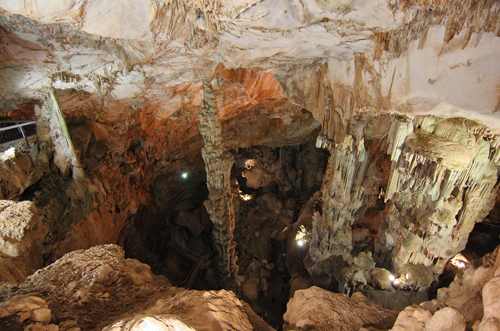 coffee
in the only café that is open at this time on a Sunday. Next we drive
to Dorgali, renowned for its artisans. But they are sleeping in on the
1st day of Pentecost. Everything is shut tight. We drive on - after a
coffee - to the caves of Inspinigoli. We go down this vertical cave a
guide for about 60 meters. Especially the stalagmites are very high.
The caves are very vulnerable. It can only be visited in groups and
visits may only take half an hour. Then the cave should be left empty
for half an hour and the lights are dimmed. Photography is
prohibited. Further down is a cave system with an underground river,
but that is only accessible to speleologists. The caves are more than
180 million years old, when the mountains rose out of the sea after an
earthquake.
coffee
in the only café that is open at this time on a Sunday. Next we drive
to Dorgali, renowned for its artisans. But they are sleeping in on the
1st day of Pentecost. Everything is shut tight. We drive on - after a
coffee - to the caves of Inspinigoli. We go down this vertical cave a
guide for about 60 meters. Especially the stalagmites are very high.
The caves are very vulnerable. It can only be visited in groups and
visits may only take half an hour. Then the cave should be left empty
for half an hour and the lights are dimmed. Photography is
prohibited. Further down is a cave system with an underground river,
but that is only accessible to speleologists. The caves are more than
180 million years old, when the mountains rose out of the sea after an
earthquake.We drive to the coastal town of Cala Gonone. We have lunch at the marina at Pizzeria al Porto. There is a strong wind. It is nice and sunny. Sometimes the gusts are so strong that the wind blows the dishes from the table. After lunch it takes us some searching for the archaeological site Nuraghe Mannu. We eventually find the exit from the road on to an upaved road we have forllow for 3km. Just when you think it is not leading anywhere, you need to go a
Then we drive back to Nuoro. We drink another spritz on the Corso Garibaldi before we go to Monti Blu. This is bric a brac shop on the ground floor with a tea room and a restaurant upstairs, which opens at 8pm. We have delicious meal with a nice wine from Oliena: Vino di Oliena Nepente Carros - Cantina Puddu made of the Cannonau grape. Erik took a pizza diavolo and for me it was lamb with shredded cheese. With the meal we got good portion again of Sardinian flatbread called Pane Carasau. It is a very thin bread baked in the oven with stones on top. According Sardinians it is better when it is thinner. Best pane carasau comes, so they say, from the province of Nuoro.
Weather: sunny 19⁰- 24⁰ with lots of strong wind
Monday 16 May 2016
Nuoro - Riola Sardo: 90 km, 1.5 hrs
Pentecost Monday is apparently not a holiday here as daily life
seems to take its course again. The children go to school and grown ups
to work. We have breakfast and drink coffee in the neighborhood before
we drive toRiola Sarde near Oristano on the west coast. We stay there at Hotel Lucrezia.
A luxury home of Parador allure. We are welcomed by Claudia, offering
us coffee and cake. After a short break we drive to Oristano. There have lunch at Trattoria di Gino. This traditional restaurant opens at 1pm and not a minute earlier. The staff is
having its own lunch before that time. In the end we have a simple but
tasty lunch here. We visit the cathedral and the Tower. But here too
public life around grinds to a halt around 2pm.
At the end of the afternoon we drive to the Sinis peninsula, to the beach of Putzu Ida. The beach is very disappointing. The resort is very poor and there is only one dodgy bar with some camping chairs outside. Behind the beach are a few salt lakes and where flamingos come at dusk, so we are told. We sure see two of, who patiently scour the bottom of the lake for snacks.
At night we eat at the hotel. Dinner is good, but not - as we expected - excellent.
Weather: Sunny 24 ° C
Tuesday 17 May 2016
We drive to the Sinis peninsula, but now to San Giovanni the Sinis. In this coastal hamlet
we find the oldest church in Sardinia. The church dating back to the
6th century got its present appearance in the 9th century. The church
is built in a cross shape and looks early Christian and Byzantine with
a red dome and irregular masonry. The church has survived centuries of
piracy on the coast through the hard work of a French religious
order, who took over the church in the 11th century under her care.
Behind San Giovanni looms the Spanish tower of Tharros. This is part
of a chain of defensive towers, built by the Spanish under Philip II as
a defense system against invading Moors from Tunisia. At the foot of
the tower is the archaeological site of Tharos. Phoenicians arrived
here 800 years BC because of the sheltered position of the bay behind
the Capo di San Marco. The Punic and Roman houses are lined along a
number of broad Roman streets with gutter in the middle, which is
covered with wooden beams. The most striking monument are two
Corinthian columns on the coast line who belonged to a Roman temple
from the first century BC. The best kept Punic building is a cistern. Furthermore, we can see the remains of thermal baths and shops.
From Tharos we drive to Salvatore. The church is a Chiesa Novenari, one that is used only nine days a year during a festival (Corsa degli Scalzi), celebrating that the image of San Salvatore wast rescued from the hands of the Moors. The village around the church is only inhabited during these nine days by pilgrims. The rest of the year, it is completely empty. In the 60s and 70s of the last century a number of "spaghetti" westerns movies were filmed here.
The next village is Cabras, where the archaeological finds from Tharros are on display in the local museum. The building is not exactly pretty, but the exhibition is interesting. Cabras is an ugly fishing village, but with a nice restaurant called Il Caminetto, where the menu includes pasta with bottarga di muggine. Bottarga is spawn of the mullet, which is pressed still inside the scrotum of the fish, and then dried. A specialty of Sardinia.
In the afternoon we have coffee at the bar around the corner of our hotel in the vi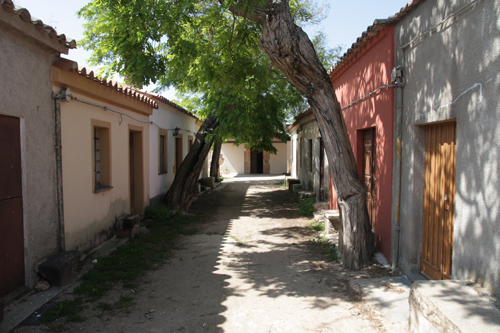 llage
of Riola Sarde and explore the village. The recommended pizzeria is
closed on Tuesdays. Other than that, the village has all kinds of small
businesses and a tiny soccer field by the river, which is fished by a
few fishermen.
llage
of Riola Sarde and explore the village. The recommended pizzeria is
closed on Tuesdays. Other than that, the village has all kinds of small
businesses and a tiny soccer field by the river, which is fished by a
few fishermen.
In the evening we eat in a hamlet Baratilli di San Pietro, that more or less merged into Riola Sardo at another pizzeria, Full Pizza de Melis Simonetta . It is in a somewhat lower price segment. For 28 euros we have a starter, two pizzas, a half liter of wine and two coffees. All served on disposable plastic dishes and glasses. The friendly service alone is worth the money. The pizzas are large, rich and of reasonable taste.
Weather: sunny, 19⁰C
Woensdag 18 May 2016
Riola Sardo - Cagliari: 110 km, 2 hrs
After breakfast and coffeeAt night we eat at Tratorria di Fabio in the Marina District near the port. Simple eatery, but nothing to complain about. Then we walk along the harbor underneath the collonades. We cross back through the Marina to the Piazza de la Constutizione, where we drink a night cap on a terrace.
Weather: light clouds 20-22⁰C
Thursday 19 May 2016
Erik wants to buy bread at a local bakery, but at 8 am there is nowhere to buy it. He has to wait until 8:30. Then we have to hurry with breakfast and coffee around the corner, because at 9.30 our guide Riccardo will be ready for a tour through the old town.
Riccardo takes us on a tour through
the old part of Cagliari. We take an elevator up to the oldest quarter,
called Castello. Built as a fortress on the highest hill in the area.
With the elevator we arrive at the royal palace, once home to viceroys
under the Aragonese / Spanish kingdom. They oversaw the more or less
autonomous administration under a feudal system. The palace is not open
until 10am, so we start with the cathedral church next to it. The
facade is in Pisan Romanesque style, but most of the church is baroque.
The showpiece is the crypt where the relics of more than 170 Sardinian
saints and martyrs are kept behind, each behind tile with a
representation of their martyrdom or miracle.
In the church, we see various parts shipped from Pisa to confirm the connection with the mother city on the mainland. Largest relic is a nail out of the "crown" of Christ, which was given by the pope in exchange for the return of a loot stolen by Sardinian pirates.
After church we visit the palace. We start in the gallery with portraits of the viceroys. It 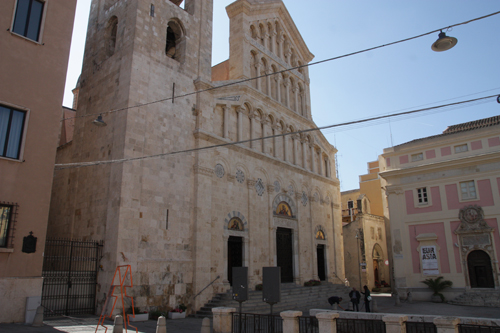 is
remarkable that the captions are only in Italian from the 18th century
onwards. Before that, the language did not actually exist. As Sardinia
was Sardinia was assignedafter the Spanish War of Succession in 1718
to Savoy, the Kingdom of Sardinia was founded (and Savoy). It becomes
tricky when the revolutionary French troops (including a certain
General Bonaparte) from Corsica, planned to invade Sardinia, but that
threat was eventually averted in 1793. From 1860, the movement
for Italian unitybegins(Il Risorgimento) starting in Sardinia driving out foreign forces (in particular, Austria and Spain) occupying
Italy. Eventually Italy becomes a kingdom under King Vittorio
Emanuele II of Savoy in 1861. He is also honored here with a large
portrait. The main room is used as a meeting room for the Regional
Council of Sardinia.
is
remarkable that the captions are only in Italian from the 18th century
onwards. Before that, the language did not actually exist. As Sardinia
was Sardinia was assignedafter the Spanish War of Succession in 1718
to Savoy, the Kingdom of Sardinia was founded (and Savoy). It becomes
tricky when the revolutionary French troops (including a certain
General Bonaparte) from Corsica, planned to invade Sardinia, but that
threat was eventually averted in 1793. From 1860, the movement
for Italian unitybegins(Il Risorgimento) starting in Sardinia driving out foreign forces (in particular, Austria and Spain) occupying
Italy. Eventually Italy becomes a kingdom under King Vittorio
Emanuele II of Savoy in 1861. He is also honored here with a large
portrait. The main room is used as a meeting room for the Regional
Council of Sardinia.
Slightly further afield is the Church and Crypt of San Efisio. Even smaller and also with similar age. San Efisio was a Roman soldier who converted to Christianity and was therefore persecuted, tortured and decapitated. Not here but in Nora. On May 1 there are processions with his image in a carriage and believers travel on foot from Cagliari to Nora, where another church is dedicated to the martyr. The saint is acclaimed for averting a plague epidemic in the 16th century by a prayer. We walk to the Marina, where we walk to the harbor through narrow streets towards via Roma. Along the way we visit the traditional almond cookies shop called Durke (meaning sweet in Sardinian). Via Roma is dominated by the colonnades with bars and cafes and even an upscale department store. The street connects
At the new city our tour ends and we say goodbye to Riccardo. In the afternoon we walk around in the Marina and have a Spritz on a terrace and we buy cookies for the home front.
At night we eat at Luigi Pommata. A fancy place for dinner. I have an Insalata di mare grigliata su crema di ricotta e displace urine croccanti as a starter. No lettuce, but fried seafood. Then spicy tuna in three variations (Ventresca di Tonno speziato in tre con cotture Cipollotto arrostito alla Vernaccia). Very tender and delicious. Erik has Sfogliatina di carasau con fl urine al Profumo di erbe aromatiche su crema di pecorino fresco (Carasau biscuits with vegetables flavored with pecorino cheese) and then Filetto di manzo cotto alla piastra con sugo d'arrosto, tartufo sardo e crema di patate all 'antica (beef fillet with rice, sardinian and truffle mashed potatoes). Finally a Composizione di frutta su centrifugato di fragole e yogurt gelato (fruit salad with yogurt and ice cream). Along with our dessert, a delicious dessert wine.
Satisfied but tired back to our apartment.
Weather: sunny and 23⁰C
Vrijdag 20 May 2016
The online check-in for tomorrow's flight home is not flawless. From the KLM site, we are redirected to Alitalia. There you get the option to book your
Today we drive by car to Nora. On the way out of town we pass a couple of lagoons close to the road in which numerous Flamingos areforaging. At Nora we drink a coffee and then go see the excavations. That is only possible with a guide. We buy a ticket for the 11-hour tour and wait. Then we suddenly see the guide leave with a group of people. That appears to be our tour. We make a run for it. The tour is informative, but at a high pace. From the Punic origins of Nora there is not much left to see. From the Roman days there is much more. The waterline of the sea has advanced about 90 meters during the millennia, so many ruins have been submerged into the water. We see some bathhouses, a small amphitheater, mansions, a sewer, hospital, market, and even more thermal baths. Near the site also is a Spanish defense tower from the 16th century.
After the visit we walk to the San Eufisio church, but that is only open on weekends. Th
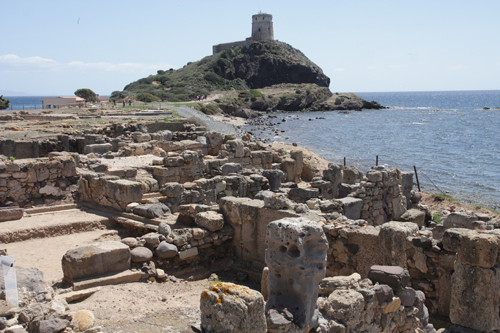 en
we drive for a ride along the south coast. But first we want to eat,
but can not find anything nearby. We find a very cheap pizzeria in
Domus de Maria. When we drive up the coast road, it appears there are
countless opportunities to get some food. The coastal road is beautiful
with lovely blue bays. Then we drive back to Cagliari, where we arrive
at 16 hours.
en
we drive for a ride along the south coast. But first we want to eat,
but can not find anything nearby. We find a very cheap pizzeria in
Domus de Maria. When we drive up the coast road, it appears there are
countless opportunities to get some food. The coastal road is beautiful
with lovely blue bays. Then we drive back to Cagliari, where we arrive
at 16 hours.At night we eat at a simple Chinese / Japanese restaurant in the Marina District. The cook is an all-rounder, because you can also (limited) Thai food. The food is not very bad and although it does not taste totally Chinese, it is cheap. After that we have a drink on a terrace on the Piazza Costituzione close to our apartment.
Weather: sunny 25°C
Saturday 21 May 2016
After breakfast we pack our suitcases and we clean the apartment. We have plenty of time and have a coffee in the Piazza Costituzione at Pico Cafè. Then we pick up the car from the parking garage on Viale Regina Elena. We pick up the suitcases, leave to wn
and drive to the airport of Cagliari. The car rental drop-off point is
not quite well marked, so we make an extra tour around the departure
hall. The drop off of the car at Sardinya is reasonably smooth. They do
a quick inspection and then we can proceed to the departure lounge. The
check in for the flight has not yet opened yet. But we can pay for our
check-in luggage. Which is not 10 euro more than the online roat - as
Alitalia had assured us - but 28 euros more. We pay and get a ticket
with 7 copies, filled in by hand and completed with stamps. It looks
very old-fashioned. After our return KLM returns this extra amount
back. Very good service.
wn
and drive to the airport of Cagliari. The car rental drop-off point is
not quite well marked, so we make an extra tour around the departure
hall. The drop off of the car at Sardinya is reasonably smooth. They do
a quick inspection and then we can proceed to the departure lounge. The
check in for the flight has not yet opened yet. But we can pay for our
check-in luggage. Which is not 10 euro more than the online roat - as
Alitalia had assured us - but 28 euros more. We pay and get a ticket
with 7 copies, filled in by hand and completed with stamps. It looks
very old-fashioned. After our return KLM returns this extra amount
back. Very good service.The flight to Rome goes smoothly. Boarding is the Italian way. It starts too late and no one is bothers abouty the procedure concerning priority for children and invalids or boarding by row. We have exit row seats or comfort seats, which Alitalia charged nothing extra for. Probably because their website is not working properly. In Rome, we have more than an hour to transfer to our connecting flight. We arrive around 5.30pm at Amsterdam Ariport Schiphol. The baggage does take long to arrive and a quarter to five we are on the train to Rotterdam. At Rotterdam Central we take an Ubertaxi, which brings us home
 |
Other Travel | |
| back | |